复现经典:《统计学习方法》第14章 聚类方法
第14章聚类方法
本文是李航老师的《统计学习方法》一书的代码复现。作者:黄海广
备注:代码都可以在github中下载。我将陆续将代码发布在公众号“机器学习初学者”,可以在这个专辑在线阅读。
1.聚类是针对给定的样本,依据它们属性的相似度或距离,将其归并到若干个“类”或“簇”的数据分析问题。一个类是样本的一个子集。直观上,相似的样本聚集在同类,不相似的样本分散在不同类。
2.距离或相似度度量在聚类中起着重要作用。
常用的距离度量有闵可夫斯基距离,包括欧氏距离曼哈顿距离、切比雪夫距离、、以及马哈拉诺比斯距离。常用的相似度度量有相关系数、夹角余弦。用距离度量相似度时,距离越小表示样本越相似;用相关系数时,相关系数越大表示样本越相似。
3.类是样本的子集,比如有如下基本定义:用 表示类或簇,用 , ;等表示类中的样本,用 表示样本 与样本 之间的距离。如果对任意的 ,有
则称 为一个类或簇。
描述类的特征的指标有中心、直径、散布矩阵、协方差矩阵。
4.聚类过程中用到类与类之间的距离也称为连接类与类之间的距离包括最短距离、最长距离、中心距离、平均距离。
5.层次聚类假设类别之间存在层次结构,将样本聚到层次化的类中层次聚类又有聚合或自下而上、分裂或自上而下两种方法。
聚合聚类开始将每个样本各自分到一个类;之后将相距最近的两类合并,建立一个新的类,重复此操作直到满足停止条件;得到层次化的类别。分裂聚类开始将所有样本分到一个类;之后将已有类中相距最远的样本分到两个新的类,重复此操作直到满足停止条件;得到层次化的类别。
聚合聚类需要预先确定下面三个要素:
(1)距离或相似度;(2)合并规则;(3)停止条件。
根据这些概念的不同组合,就可以得到不同的聚类方法。
6. 均值聚类是常用的聚类算法,有以下特点。基于划分的聚类方法;类别数k事先指定;以欧氏距离平方表示样本之间的距离或相似度,以中心或样本的均值表示类别;以样本和其所属类的中心之间的距离的总和为优化的目标函数;得到的类别是平坦的、非层次化的;算法是迭代算法,不能保证得到全局最优。
均值聚类算法,首先选择k个类的中心,将样本分到与中心最近的类中,得到一个聚类结果;然后计算每个类的样本的均值,作为类的新的中心;重复以上步骤,直到收敛为止。
层次聚类
聚合(自下而上):聚合法开始将每个样本各自分裂到一个类,之后将相距最近的两类合并,建立一个新的类,重复次操作知道满足停止条件,得到层次化的类别。
分裂(自上而下):分裂法开始将所有样本分到一个类,之后将已有类中相距最远的样本分到两个新的类,重复此操作直到满足停止条件,得到层次化的类别。
k均值聚类
k均值聚类是基于中心的聚类方法,通过迭代,将样本分到k个类中,使得每个样本与其所属类的中心或均值最近,得到k个平坦的,非层次化的类别,构成对空间的划分。
import math
import random
import numpy as np
from sklearn import datasets,cluster
import matplotlib.pyplot as plt
iris = datasets.load_iris()
gt = iris['target'];gt
array([0, 0, 0, 0, 0, 0, 0, 0, 0, 0, 0, 0, 0, 0, 0, 0, 0, 0, 0, 0, 0, 0,
0, 0, 0, 0, 0, 0, 0, 0, 0, 0, 0, 0, 0, 0, 0, 0, 0, 0, 0, 0, 0, 0,
0, 0, 0, 0, 0, 0, 1, 1, 1, 1, 1, 1, 1, 1, 1, 1, 1, 1, 1, 1, 1, 1,
1, 1, 1, 1, 1, 1, 1, 1, 1, 1, 1, 1, 1, 1, 1, 1, 1, 1, 1, 1, 1, 1,
1, 1, 1, 1, 1, 1, 1, 1, 1, 1, 1, 1, 2, 2, 2, 2, 2, 2, 2, 2, 2, 2,
2, 2, 2, 2, 2, 2, 2, 2, 2, 2, 2, 2, 2, 2, 2, 2, 2, 2, 2, 2, 2, 2,
2, 2, 2, 2, 2, 2, 2, 2, 2, 2, 2, 2, 2, 2, 2, 2, 2, 2])
3类
iris['data'][:,:2].shape
(150, 2)
data = iris['data'][:,:2]
x = data[:,0]
y = data[:,1]
plt.scatter(x, y, color='green')
plt.xlim(4, 8)
plt.ylim(1, 5)
plt.show()
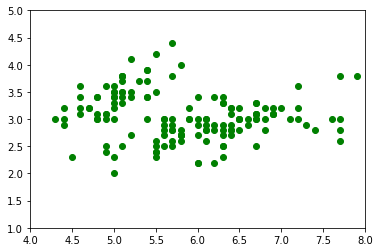
# 定义聚类数的节点
class ClusterNode:
def __init__(self, vec, left=None, right=None, distance=-1, id=None, count=1):
"""
:param vec: 保存两个数据聚类后形成新的中心
:param left: 左节点
:param right: 右节点
:param distance: 两个节点的距离
:param id: 用来标记哪些节点是计算过的
:param count: 这个节点的叶子节点个数
"""
self.vec = vec
self.left = left
self.right = right
self.distance = distance
self.id = id
self.count = count
def euler_distance(point1: np.ndarray, point2: list) -> float:
"""
计算两点之间的欧拉距离,支持多维
"""
distance = 0.0
for a, b in zip(point1, point2):
distance += math.pow(a - b, 2)
return math.sqrt(distance)
# 层次聚类(聚合法)
class Hierarchical:
def __init__(self, k):
self.k = k
self.labels = None
def fit(self, x):
nodes = [ClusterNode(vec=v, id=i) for i, v in enumerate(x)]
distances = {}
point_num, feature_num = x.shape
self.labels = [-1] * point_num
currentclustid = -1
while(len(nodes)) > self.k:
min_dist = math.inf
nodes_len = len(nodes)
closest_part = None
for i in range(nodes_len - 1):
for j in range(i+1, nodes_len):
d_key = (nodes[i].id, nodes[j].id)
if d_key not in distances:
distances[d_key] = euler_distance(nodes[i].vec, nodes[j].vec)
d = distances[d_key]
if d < min_dist:
min_dist = d
closest_part = (i, j)
part1, part2 = closest_part
node1, node2 = nodes[part1], nodes[part2]
new_vec = [ (node1.vec[i] * node1.count + node2.vec[i] * node2.count ) / (node1.count + node2.count)
for i in range(feature_num)]
new_node = ClusterNode(vec=new_vec,
left=node1,
right=node2,
distance=min_dist,
id=currentclustid,
count=node1.count + node2.count)
currentclustid -= 1
del nodes[part2], nodes[part1]
nodes.append(new_node)
self.nodes = nodes
self.calc_label()
def calc_label(self):
"""
调取聚类的结果
"""
for i, node in enumerate(self.nodes):
# 将节点的所有叶子节点都分类
self.leaf_traversal(node, i)
def leaf_traversal(self, node: ClusterNode, label):
"""
递归遍历叶子节点
"""
if node.left == None and node.right == None:
self.labels[node.id] = label
if node.left:
self.leaf_traversal(node.left, label)
if node.right:
self.leaf_traversal(node.right, label)
# https://zhuanlan.zhihu.com/p/32438294
my = Hierarchical(3)
my.fit(data)
labels = np.array(my.labels)
print(labels)
[2 2 2 2 2 2 2 2 2 2 2 2 2 2 2 2 2 2 2 2 2 2 2 2 2 2 2 2 2 2 2 2 2 2 2 2 2
2 2 2 2 2 2 2 2 2 2 2 2 2 0 0 0 0 0 0 0 2 0 2 2 0 0 0 0 0 0 0 0 0 0 0 0 0
0 0 0 0 0 0 0 0 0 0 0 0 0 0 0 0 0 0 0 2 0 0 0 0 2 0 0 0 1 0 0 1 2 1 0 1 0
0 0 0 0 0 0 1 1 0 0 0 1 0 0 1 0 0 0 1 1 1 0 0 0 1 0 0 0 0 0 0 0 0 0 0 0 0
0 0]
# visualize result
cat1 = data[np.where(labels==0)]
cat2 = data[np.where(labels==1)]
cat3 = data[np.where(labels==2)]
plt.scatter(cat1[:,0], cat1[:,1], color='green')
plt.scatter(cat2[:,0], cat2[:,1], color='red')
plt.scatter(cat3[:,0], cat3[:,1], color='blue')
plt.title('Hierarchical clustering with k=3')
plt.xlim(4, 8)
plt.ylim(1, 5)
plt.show()
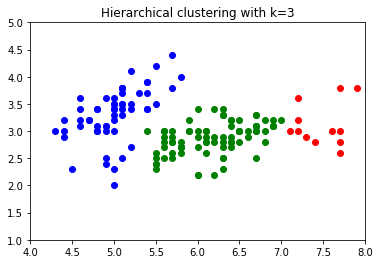
sk = cluster.AgglomerativeClustering(3)
sk.fit(data)
labels_ = sk.labels_
print(labels_)
[1 1 1 1 1 1 1 1 1 1 1 1 1 1 1 1 1 1 1 1 1 1 1 1 1 1 1 1 1 1 1 1 1 1 1 1 1
1 1 1 1 1 1 1 1 1 1 1 1 1 0 0 0 2 0 2 0 1 0 1 1 0 2 0 2 0 2 2 2 2 0 0 2 0
0 0 0 0 0 2 2 2 2 0 2 0 0 2 2 2 2 0 2 1 2 2 2 0 1 2 0 2 0 0 0 0 1 0 0 0 0
0 0 2 2 0 0 0 0 2 0 2 0 0 0 0 0 0 0 0 0 0 0 0 0 0 0 0 0 0 0 0 2 0 0 0 2 0
0 0]
# visualize result of sklearn
cat1_ = data[np.where(labels_==0)]
cat2_ = data[np.where(labels_==1)]
cat3_ = data[np.where(labels_==2)]
plt.scatter(cat1_[:,0], cat1_[:,1], color='green')
plt.scatter(cat2_[:,0], cat2_[:,1], color='red')
plt.scatter(cat3_[:,0], cat3_[:,1], color='blue')
plt.title('Hierarchical clustering with k=3')
plt.xlim(4, 8)
plt.ylim(1, 5)
plt.show()
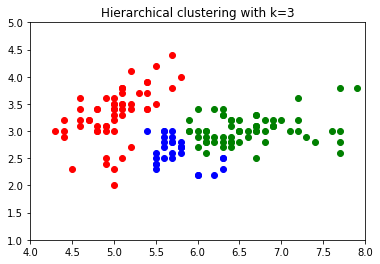
# kmeans
class MyKmeans:
def __init__(self, k, n=20):
self.k = k
self.n = n
def fit(self, x, centers=None):
# 第一步,随机选择 K 个点, 或者指定
if centers is None:
idx = np.random.randint(low=0, high=len(x), size=self.k)
centers = x[idx]
#print(centers)
inters = 0
while inters < self.n:
#print(inters)
#print(centers)
points_set = {key: [] for key in range(self.k)}
# 第二步,遍历所有点 P,将 P 放入最近的聚类中心的集合中
for p in x:
nearest_index = np.argmin(np.sum((centers - p) ** 2, axis=1) ** 0.5)
points_set[nearest_index].append(p)
# 第三步,遍历每一个点集,计算新的聚类中心
for i_k in range(self.k):
centers[i_k] = sum(points_set[i_k])/len(points_set[i_k])
inters += 1
return points_set, centers
m = MyKmeans(3)
points_set, centers = m.fit(data)
centers
array([[5.006 , 3.428 ],
[6.81276596, 3.07446809],
[5.77358491, 2.69245283]])
# visualize result
cat1 = np.asarray(points_set[0])
cat2 = np.asarray(points_set[1])
cat3 = np.asarray(points_set[2])
for ix, p in enumerate(centers):
plt.scatter(p[0], p[1], color='C{}'.format(ix), marker='^', edgecolor='black', s=256)
plt.scatter(cat1_[:,0], cat1_[:,1], color='green')
plt.scatter(cat2_[:,0], cat2_[:,1], color='red')
plt.scatter(cat3_[:,0], cat3_[:,1], color='blue')
plt.title('Hierarchical clustering with k=3')
plt.xlim(4, 8)
plt.ylim(1, 5)
plt.show()
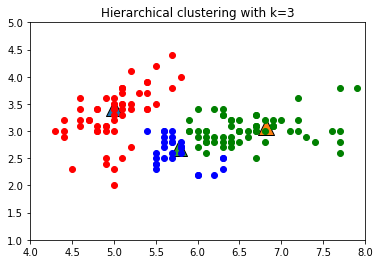
# using sklearn
from sklearn.cluster import KMeans
kmeans = KMeans(n_clusters=3, max_iter=100).fit(data)
gt_labels__ = kmeans.labels_
centers__ = kmeans.cluster_centers_
gt_labels__
array([1, 1, 1, 1, 1, 1, 1, 1, 1, 1, 1, 1, 1, 1, 1, 1, 1, 1, 1, 1, 1, 1,
1, 1, 1, 1, 1, 1, 1, 1, 1, 1, 1, 1, 1, 1, 1, 1, 1, 1, 1, 1, 1, 1,
1, 1, 1, 1, 1, 1, 0, 0, 0, 2, 0, 2, 0, 2, 0, 2, 2, 2, 2, 2, 2, 0,
2, 2, 2, 2, 2, 2, 2, 2, 0, 0, 0, 0, 2, 2, 2, 2, 2, 2, 2, 2, 0, 2,
2, 2, 2, 2, 2, 2, 2, 2, 2, 2, 2, 2, 0, 2, 0, 0, 0, 0, 2, 0, 0, 0,
0, 0, 0, 2, 2, 0, 0, 0, 0, 2, 0, 2, 0, 2, 0, 0, 2, 2, 0, 0, 0, 0,
0, 2, 2, 0, 0, 0, 2, 0, 0, 0, 2, 0, 0, 0, 2, 0, 0, 2])
centers__
array([[6.81276596, 3.07446809],
[5.006 , 3.428 ],
[5.77358491, 2.69245283]])
# visualize result
cat1 = data[gt_labels__ == 0]
cat2 = data[gt_labels__ == 1]
cat3 = data[gt_labels__ == 2]
for ix, p in enumerate(centers__):
plt.scatter(p[0], p[1], color='C{}'.format(ix), marker='^', edgecolor='black', s=256)
plt.scatter(cat1_[:,0], cat1_[:,1], color='green')
plt.scatter(cat2_[:,0], cat2_[:,1], color='red')
plt.scatter(cat3_[:,0], cat3_[:,1], color='blue')
plt.title('kmeans using sklearn with k=3')
plt.xlim(4, 8)
plt.ylim(1, 5)
plt.show()
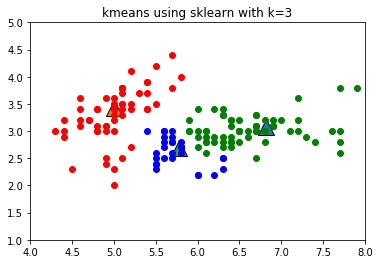
寻找 K 值
from sklearn.cluster import KMeans
loss = []
for i in range(1, 10):
kmeans = KMeans(n_clusters=i, max_iter=100).fit(data)
loss.append(kmeans.inertia_ / len(data) / 3)
plt.title('K with loss')
plt.plot(range(1, 10), loss)
plt.show()

例 14.2
X = [[0, 2], [0, 0], [1, 0], [5, 0], [5, 2]]
np.asarray(X)
array([[0, 2],
[0, 0],
[1, 0],
[5, 0],
[5, 2]])
m = MyKmeans(2, 100)
points_set, centers = m.fit(np.asarray(X))
points_set
{0: [array([0, 2]), array([0, 0]), array([1, 0])],
1: [array([5, 0]), array([5, 2])]}
centers
array([[0, 0],
[5, 1]])
kmeans = KMeans(n_clusters=2, max_iter=100).fit(np.asarray(X))
kmeans.labels_
array([0, 0, 0, 1, 1])
kmeans.cluster_centers_
array([[0.33333333, 0.66666667],
[5. , 1. ]])
本章代码来源:https://github.com/hktxt/Learn-Statistical-Learning-Method
下载地址
https://github.com/fengdu78/lihang-code
参考资料:
[1] 《统计学习方法》: https://baike.baidu.com/item/统计学习方法/10430179
[2] 黄海广: https://github.com/fengdu78
[3] github: https://github.com/fengdu78/lihang-code
[4] wzyonggege: https://github.com/wzyonggege/statistical-learning-method
[5] WenDesi: https://github.com/WenDesi/lihang_book_algorithm
[6] 火烫火烫的: https://blog.csdn.net/tudaodiaozhale
[7] hktxt: https://github.com/hktxt/Learn-Statistical-Learning-Method
